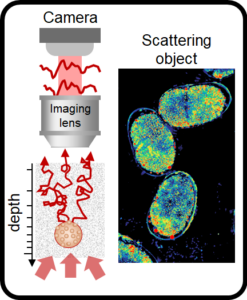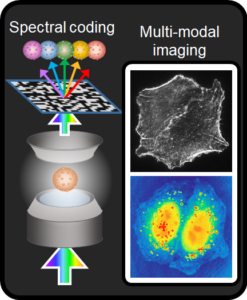The goal of my research group is to develop next generation smart optical-imaging technologies for applications in science and medicine. Specific areas of focus in our research include light-physics, optical microscope design, computational reconstruction, multi-dimensional imaging, and large-scale data analysis. We strive to direct technical developments into creative and powerful solutions addressing the imaging challenges in current scientific applications. As such, our research is highly interdisciplinary and tightly integrates together theory, engineering, data-science, and scientific translation.
For a better sense of this type of work, please check out some of my past graduate and post-doctoral research projects, which are presented in a quasi-technical manner [here].
Computational microscopy
A key theme in our research is the development of computational microscopes. These new class of microscopes combine customized imaging hardware with advanced computational algorithms to achieve unprecedented imaging capabilities. A generalized imaging pipeline is illustrated below to demonstrate how a computational microscope functions.

Limitations in traditional microscopy
There is no universal imaging tool for all applications. A scientist must be familiar with the needs of their applications and available imaging capabilities before deciding which system to use. Generally, this decision becomes a consideration of trade-offs acceptable to the application. Below is a simple graphic illustrating how a single imaging system exists within a domain bound by specific imaging criteria. Traditional imaging systems bound by practical and physical constraints often can prioritize some criteria only by neglecting others. Computational microscopy is not bound by such constraints and can better navigate this domain.

Research directions
Specific research projects are always in flux. However, I am particularly interested in a few broad research directions, as listed below. Students are encouraged and expected to use their creativity to develop specific research projects pursuing these broad directions. Students are also encouraged to come up with original ideas for broad research directions well suited for our group to pursue.
Every project below will require the co-development of customized optical microscopes alongside novel computational reconstruction frameworks. These frameworks will utilize both physics-based models as well as machine learning ‘black box’ tools. The general goal will be to develop hardware-and-software imaging solutions for experimental applications within these research directions.
 3D imaging through multiple scatter
3D imaging through multiple scatter
Importance: Optical imaging’s utility in the sciences is severely hindered by light scattering, which limits imaging depths to < 0.5 mm. Scattering imposes this limit by essentially scrambling the information that is carried by light into the imaging system. This is a fundamental problem faced by optical imaging in all areas of science, such as pathology, neuroscience, etc.
Goal: This project direction develops hardware and software “decoding” pipelines that unscramble this light scattering process. The goal is to use a joint hardware/software imaging pipeline to achieve deeper imaging into optically scattering objects, limited only by computational power and physical constraints.
 Ultra-fast 4D tomography
Ultra-fast 4D tomography
Importance: High-resolution imaging in 4 dimensions (3D space and 1D time) is important to gain a holistic understanding of various scientific phenomena. Traditional microscopy can output spatially-3D datasets by synthesizing together multiple 2D measurements and assuming that the object remains generally static between measurements. Unfortunately, this is not true for highly dynamic objects that rapidly change between measurements. This represents a major challenge in generalizing optical microscopy’s utility across the sciences.
Goal: This project direction develops an imaging pipeline where 1) an object’s space-time information can be efficiently encoded into raw measurements via hardware coding modules; and 2) robustly decoded and reconstructed back out via advanced computational solvers.
 Multi-dimensional microscopy
Multi-dimensional microscopy
Importance: A key benefit of optical imaging is the availability of various optical phenomena as independent contrast mechanisms, such as fluorescence, refractive-index, spectroscopy, polarization, etc. Visualizing science across these diverse contrast dimensions enables more comprehensive understanding. Unfortunately, it is difficult to integrate these various dimensions into robust and efficient imaging frameworks.
Goal: This project direction develops microscope systems that measure object properties across multiple contrast dimensions. A key component of this direction will be to develop efficient mechanisms to encode various optical phenomena into raw measurements. These encoding mechanisms must be designed allow robust decoding of the multidimensionsal signal after acquisition.
